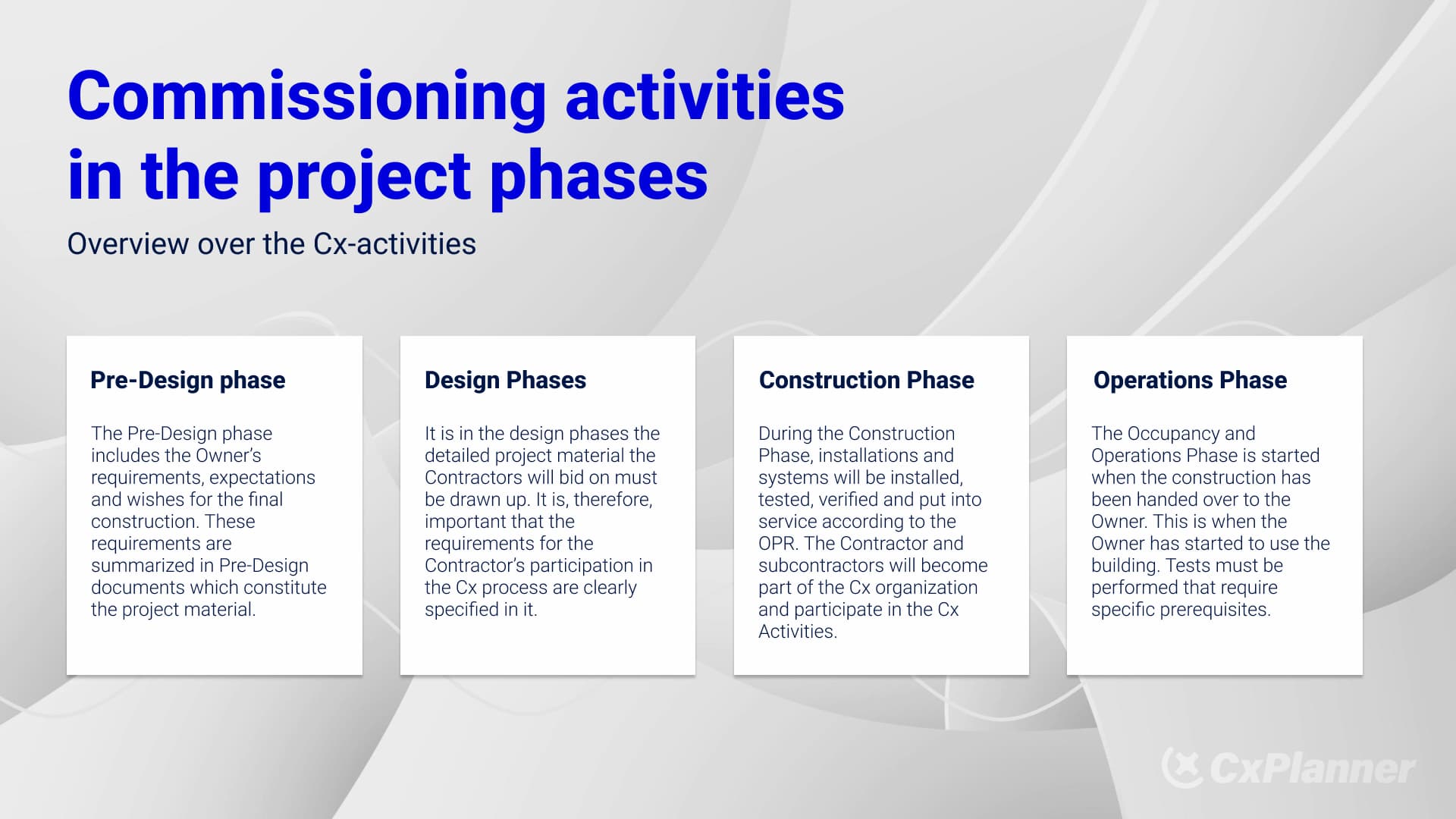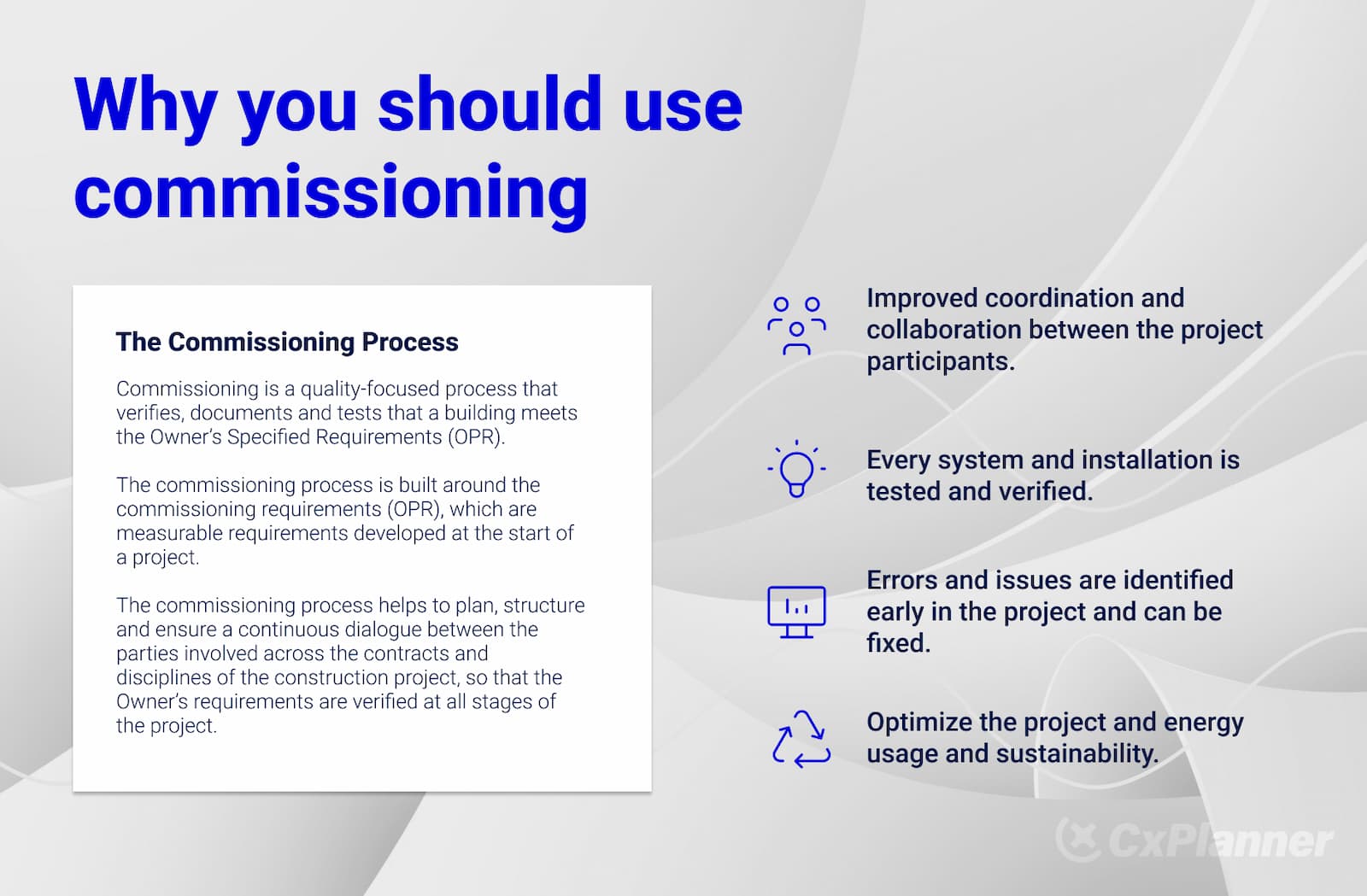Table of content

 What is the commissioning process?
What is the commissioning process?
People involved in construction projects often ask us this. The short answer is that commissioning is a support process for testing technical installations.
The purpose of commissioning is to ensure that the developer's/owners/clients requirements for the building are met.
There are many ways to handle commissioning, but we believe that it should be a practical process that benefits everyone in a construction project!
 Where does the process commissioning originate from?
Where does the process commissioning originate from?
The commissioning process originates from the shipbuilding industry. A commissioned ship is a ship that is completed and ready to sail.
Before the ship can receive this title, it must pass a series of tests. The equipment on the ship must be thoroughly tested, problems must be identified and solved, and it must be ensured that the crew is trained in the operation and maintenance of the ship.
This methological approach has been adopted by the construction industry, and the termonology "Building Commissioning Process" has been used since the 1980s.
 The history of the word commissioning
The history of the word commissioning
The word "Commissioning" on the other hand, originates from Latin, where it started as the word committere. It is a compound of the two Latin words com (with, together) and mittere (to give slip, send off, cast). The two words combined formed committere, which means: to unite, connect, combine and to assemble.
From committere, it became commissionem (Latin) to commission (Old French) and finally to the English commission in the middle of the 1300s. At that time, the meaning of the word was:
commission (mid 1300s) - authority entrusted to someone, delegated authority or power
After a few years, in the late 1400s, the meaning was changed to:
commission (late 1400s) - body of persons charged with authority for the performance of certain special duties
In the 1560s, the meaning of the word was changed again, still with the same underlying meaning.
commission (late 1560s) - anything entrusted to anyone to perform
 Why should you use the commissioning process?
Why should you use the commissioning process?

Buildings are becoming more complex and systems are becoming more interactive. Increased complexity and interactivity increases the possibility that small errors can have a big impact on performance and efficiency.
The commissioning process helps to plan, structure and ensure a continuous dialogue between the parties involved so that the owner's requirements are verified across interfaces and met at the completion of the building.
Additional benefits:
- The building meets the owner's requirements and expectations
- Fewer defects and deficiencies at completion
- Installations, facilities and systems are verified and meet the owner's requirements
- Operating staff are trained and instructed in the operation and maintenance of the building
- Operating costs are minimized
- Interfaces between the different players in the project are handled
- Interdisciplinary dialogue throughout the project
- Optimized energy consumption and operating scenario
- Documentation is delivered and structured and can be used in the planned D&V procedures
- Continuous monitoring and optimization of the building's performance
- A satisfied owner
 A process focusing on quality in every aspect
A process focusing on quality in every aspect
The commissioning process is a quality assurance process that verifies and documents that a building meets the clients requirements.
The process starts at the very beginning of a construction project, and it extends through the project and into the operation of the building.
The commissioning process verifies that all interfaces have been addressed and technical installations are functioning correctly. It also optimizes the collaboration between the parties involved in a construction project.
It requires a high technical skillset to perform the commissioning. The process is often managed by the commissioning manager with dedicated commissioning software solutions or spreadsheets.
 Who is involved in the commissioning process?
Who is involved in the commissioning process?
The Cx process is often referred to as the "owner's process". This makes sense, since the owner is the one who pays for the commissioning process.
However, we have seen a shift in this area in recent years, with multiple turnkey contractors establishing their own commissioning divisions.
That said, what the commissioning process actually includes is ultimately up to the owner, since the owners's commissioning requirements (OPR) are the foundation of the process. Consequently, the owner must list the requirements (OPR) to be verified during the commissioning process.
 Cx activities through the different phases
Cx activities through the different phases
The commissioning process follows all phases of construction, from the program phase to operation.
It is a quality-oriented control and documentation process that is part of the building project. It incorporates existing work processes and focuses on areas that are not typically covered by traditional quality assurance processes.
The commissioning process is carried out in the respective construction phases, and the phase division generally follows the traditional work phases with pre-design, design, execution, and operation.
If commissioning is implemented in a later phase than the program phase, the commissioning activities that should have been performed in the preceding phases must be carried out.